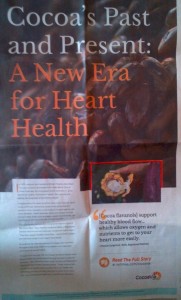Five more food-industry funded research studies with predictable results. Score 65:3.
Let me start with a reminder that since mid-March I’ve been collecting examples of studies funded by food companies or trade associations that come up with results favorable to the sponsor’s interests. I post them five at a time. I am having a hard time finding industry-funded studies that do not favor the sponsor’s interests. If you run across any, please send. Here’s the latest collection.
Mediterranean Diet and Invasive Breast Cancer Risk Among Women at High Cardiovascular Risk in the PREDIMED Trial: A Randomized Clinical Trial. Estefanía Toledo, MD, MPH, PhD; Jordi Salas-Salvadó, MD, PhD; Carolina Donat-Vargas, PharmD; et al. JAMA Intern Med. Published online September 14, 2015. doi:10.1001/jamainternmed.2015.4838
- Conclusions and Relevance This is the first randomized trial finding an effect of a long-term dietary intervention on breast cancer incidence. Our results suggest a beneficial effect of a Mediterranean diet supplemented with extra-virgin olive oil in the primary prevention of breast cancer.
- Conflict of Interest Disclosures: Dr Salas-Salvadó received grants from Instituto de Salud Carlos III and the International Nut and Dried Fruit Foundation during the conduct of the study and has received consultancy fees from Danone Research and Eroski outside the present work; he is also a nonpaid member of the Scientific Committee of the International Nut and Dried Fruit Foundation. Dr Estruch, outside the present work, has received grants from the California Walnut Commission, nonfinancial support from Patrimonio Comunal Olivarero (Spain), La Morella Nuts (Spain), and Borges SA (Spain) and grants from Novartis Farmaceutica SA, Cerveceros De España, Sanofi, FIVIN-Spain, Instituto Cervantes Albuquerque, the Harvard School of Public Health, the Culinary Institute of America, the International Family Doctors Association, and Instituto Cervantes (Milan, Italy). Dr Ros, during the conduct of the study, received grants from Instituto de Salud Carlos III and nonfinancial support from the California Walnut Commission, Patrimonio Comunal Olivarero, La Morella Nuts, and Borges SA. Dr Ros, outside the present work, has received grants from the California Walnut Commission and nonfinancial support from Nuts for Life, La Asturiana SA, the International Nut and Dried Fruit Council, and the California Walnut Commission and personal fees and other compensation from Nuts for Life and La Asturiana SA. Dr Hu, outside the present work, has received grants from the California Walnut Commission and Metagenics. Dr Fitó, outside the present work, has received personal fees from Menarini and AstraZeneca. No other disclosures are reported.
- Funding/Support: Although most funding support came from government agencies, “The supplemental foods used in the study were generously donated by Patrimonio Comunal Olivarero and Hojiblanca, Spain (EVOO); the California Walnut Commission, Sacramento, California (walnuts); and Borges SA (almonds) and La Morella Nuts (hazelnuts), both from Reus, Spain.”
Evaluation of 4-methylimidazole, in the Ames/Salmonella test using induced rodent liver and lung S9 Carol Beevers1,* and Richard H. Adamson. Environ. Mol. Mutagen., Article first published online: 10 SEP 2015. DOI: 10.1002/em.21968.
- Conclusions: No induction of mutation (as measured by an increase in revertant colonies) was observed and it was concluded that 4-MeI was not mutagenic in S. typhimurium using either rodent liver or lung S9 for exogenous metabolism.
- Conflicts of Interest: The work described in this publication…was funded entirely by the American Beverage Association. ABA had no direct involvement in the study design, collection, analysis or interpretation of the data. ABA were not involved in the writing of this manuscript or the decision to submit the manuscript for publication. Richard H Adamson has received fees for serving as a consultant for the American Beverage Association. He was an observer for the International Technical Caramel Association for IARC Monograph- volume 101 and acted as Study Monitor for the work described in this manuscript. Carol Beevers is an employee of Covance Laboratories Ltd and acted as GLP Study Director for the work described in this manuscript.
- Comment: 4-MEI is a chemical produced during the Maillard (browning) reaction and found as a component of caramel coloring in diet sodas. It is listed as a probable carcinogen under California’s proposition 65 rules, and CSPI has petitioned the FDA to require companies to remove it.
Reduced Symptoms of Inattention after Dietary Omega-3 Fatty Acid Supplementation in Boys with and without Attention Deficit/Hyperactivity Disorder. Dienke J Bos, Bob Oranje, E Sanne Veerhoek, Rosanne M Van Diepen, Juliette MH Weusten, Hans Demmelmair, Berthold Koletzko, Monique GM de Sain-van der Velden, Ans Eilander, Marco Hoeksma, and Sarah Durston. Neuropsychopharmacology. 2015 Sep; 40(10): 2298–2306. Published online 2015 Apr 22. doi: 10.1038/npp.2015.73.
- Conclusion: this study offers support that omega-3 supplementation may be an effective augmentation for pharmacological treatments of ADHD [Attention deficit/hyperactivity disorder].
- Funding: This study was financially supported by Unilever Research & Development, Vlaardingen, The Netherlands. Unilever Research & Development was involved in the conception and design of the study. They provided financial support for research staff to run the study and provided the intervention product. Marco Hoeksma and Ans Eilander are employees of Unilever.
Milk Modulates Campylobacter Invasion into Caco-2 Intestinal Epithelial Cells. Rogier Louwen, R. J. Joost van Neerven. European Journal of Microbiology and Immunology 5 (2015) 3, pp. 1–7 2015. doi:10.1556/1886.2015.00019.
- Conclusions: We found that all milk products modulated the invasion of Campylobacter species into the Caco-2 cells in a dose-dependent manner…This in vitro study shows for the first time that pasteurized and formula milk affect the invasion of Campylobacter… Industrially made milk-based formulas…specifically reduced the invasion of the C. coli and C. fetus strain into the Caco-2 cells.
- Funding: “Part of this study was supported by FrieslandCampina by paying material costs, but FrieslandCampina was not involved in study design or data analysis.”
- Comment: FrieslandCampina makes dairy-based beverages, infant nutrition, cheese and desserts, and sells them in Europe, Asia, and Africa. The study results suggest that even pasteurized milk contains substances that reduce pathogenic bacteria, at least in cell cultures.
Effect of the probiotic strain Bifidobacterium animalis subsp. lactis, BB-12®, on defecation frequency in healthy subjects with low defecation frequency and abdominal discomfort: a randomised, double-blind, placebo-controlled, parallel-group trial. Dorte Eskesen, Lillian Jespersen, Birgit Michelsen, Peter J. Whorwell, Stefan Müller-Lissner and Cathrine M. Morberg. British Journal of Nutrition. DOI: http://dx.doi.org/10.1017/S0007114515003347 , 9 pages. Published online: 18 September 2015.
- Conclusions: Overall, 4 weeks’ supplementation with the probiotic strain BB-12® resulted in a clinically relevant benefit on defecation frequency. The results suggest that consumption of BB-12® improves the GI health of individuals whose symptoms are not sufficiently severe to consult a doctor.
- Funding: Design, conduct, analysis and reporting of the study, as well as writing of this manuscript, were funded in full by Chr. Hansen…S. M.-L. and P. J. W. perform consultancy work for Chr. Hansen A/S. L. J., D. E., C. M. M. and B. M. are employees of Chr. Hansen A/S.
- Comment: Chr. Hansen develops and produces cultures, enzymes and probiotics for the dairy industry in particular as well as products for dietary supplements, pharmaceuticals and infant formula.





